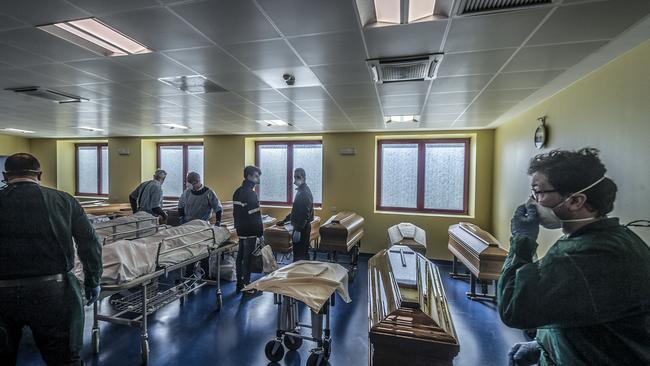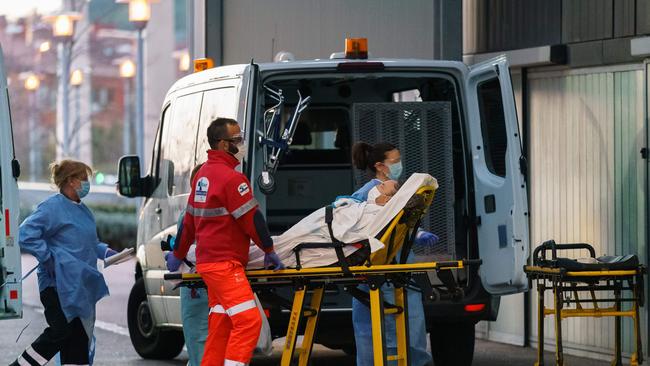No one noticed Italy’s silent time bomb until it exploded
Authorities have pieced together the events that plunged the country into a deadly coronavirus spiral that shocked the world.

On February 29, the mayor of Milan, Beppe Sala, snapped a selfie for Instagram while pointing to a T-shirt emblazoned with the words “Milano non si ferma” (Milan never stops). His plea — that the city not succumb to the virus of fear — was “liked” by more than 44,030 people.
Just one month later, more than 8000 Italians have died in the COVID-19 pandemic and Milan’s streets and piazzas remain empty.
For weeks now, Angelo Borelli, head of the Civil Protection Agency, has conducted grim daily updates on infections, deaths and the country’s desperate attempts to “flatten the curve” of contagion and cushion the beleaguered health system.
This week he, too, was absent after spiking a fever.
As European cities such as London succumb to an eerie quiet and brace for the worst of the coronavirus onslaught, there is ongoing dread in Italy about the continuing, dizzying death toll that is now more than double the number of fatalities in China, where the virus began, and matched in its most recent ferocity only by Spain.
This week, while Spanish officials signalled a tiny ray of hope as the country’s death rate began to stabilise, Italian epidemiologists and virologists were piecing together how the virus was able to spread for so long before the warning bells were sounded.
Massimo Galli, a professor at the University of Milan’s department of biomedical and clinical sciences and director of the Sacco Hospital’s department of infectious disease, describes what has unfolded as the “most unfortunate scenario possible”.
Epidemiological data, he tells Inquirer, shows the virus began to spread in northern Italy in January, remaining undetected for weeks. When the first case, known as “patient one”, was identified in February, his early treatment began in a small regional hospital without testing or safety precautions.

Now identified by his first name only, Mattia, the 38-year-old employee of Unilever and avid footballer and marathon runner, arrived in Codogno Hospital on February 18 with symptoms of a mild pneumonia.
The young man spent half a day in the medical unit, visited by physicians and nurses, friends, family and his pregnant wife, but chose to return home after being checked over. He returned to hospital the following day when his illness dramatically worsened.
The physician who eventually diagnosed him, Annalisa Malara, reported that when he returned and his body failed to respond to known treatment, she had to countenance the unthinkable — that it could be the virus ravaging China.
Malara asked Mattia’s wife if he had had contact with Chinese colleagues. She confirmed there had been a dinner a few weeks earlier. “I thought that to help him, I had to look for something I thought impossible.” (Both colleagues later tested negative.)
Despite the urgency of her hunch, Malara was forced to press for permission to test for SARS-CoV-2 after being told the test request breached medical protocols for mild pneumonia.
“Abiding by ‘medical rules’ is one of the reasons this virus was allowed to circulate undisturbed for weeks,” Malara says. The test was sent for analysis at 1pm on February 20 and was returned positive about seven hours later.
Galli says in these early days, hospitals became “terrifyingly efficient” vehicles for spread of the disease, exposing those who were already ill and therefore most vulnerable to its ravages before anyone else.
“Patient zero (the original source of the infection, before Mattia) had no reason to believe he was infected. The virus snaked its way through (the community) until that first wave of infections turned to the worst and then finally came to the attention of national health authorities,” he tells Inquirer.
“We became aware of the flames only when the fire had already enveloped the greatest part of the first floor: but it was an accidental scenario … one that could have happened anywhere.”
During the first critical weeks, before the outbreak was identified, it is likely that many patients who were assumed to have succumbed to respiratory complications stemming from other conditions were also infected with COVID-19.
However, in Codogno the hospital was quickly overwhelmed by sheer numbers, and as patients were rerouted to nearby Lodi the disease spread ever further.
But there were more ingredients that had already silently — and lethally — added to what brewed into the perfect storm. A few weeks before, on February 6, a Frecciarossa high-speed train was derailed in the area, killing two passengers and injuring others. The police officers who attended and helped ferry the injured passengers to Lodi hospital had no reason to use masks or personal protection protocols, mingling freely with crowds who gathered. Between eight and 10 days later, several would test positive for COVID-19.
However, on February 19, a group from the same Carabinieri (national police) and local police were deployed to Milan’s San Siro Stadium to help maintain order during the Valencia-Atalanta (Bergamo) Champions League football match. The match, described later by Fabiano Di Marco, a respiratory specialist in Bergamo, as the detonator of a “biological atom bomb”, was attended by 45,000 fans who had travelled from Bergamo — now Italy’s worst-hit COVID-19 city — and Spain. Huge crowds surged through Milan’s train and bus system, spilling into the city’s piazzas, restaurants and bars. And a few days later, on February 23, some of these same officers were once more called back to the area to help police with the lockdown that finally had been declared in Lodi.
By March 10, when a home game was played in Valencia, one-third of the players tested positive to COVID-19.
The virus was rife in Bergamo and Lombardy and had been exported into Spain’s most “Italianate” city, which became a first hotspot for the outbreak that has since enveloped the Iberian Peninsula.
The epidemic has not only highlighted Italy’s dramatically declining birthrate and the difficulties of managing the health needs of the world’s second oldest population — not to mention a 24 per cent smoking rate — but also has reignited debate about the rapid privatisation of the health system in Lombardy.
Public hospital beds in the region have halved during the past 20 years, replaced by private beds and a systemic, continuing push towards an increasingly entrepreneurial health market. In 2017, private hospitals took 35 per cent of all hospital admissions — and 40 per cent of the region’s funds — but with a clear skew to non-life threatening cases and longer admissions. This meant, at least in the earliest days, there were hospitals that managed the crisis internally, shielded from the rigours of public health scrutiny.
On Wednesday night in Geneva, World Health Organisation director-general Tedros Adhanom Ghebreyesus held a virtual press conference for global media. Asked about Italy, he praised Italian doctors and their “heroic efforts”.
“There are some good signs now and we had discussions with some senior experts from Italy today and we think these positive signals will continue.”
Asked if he felt the same optimism, Galli was rather more circumspect: “Ci piacerebbe,” he said. “We would like that.”
Paola Totaro is a London-based Australian freelance journalist.
